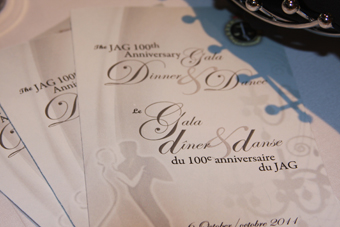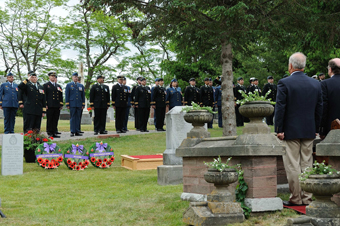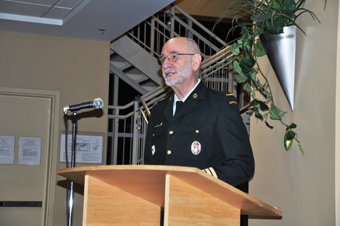ARCHIVED - Chapter 2: 100th Anniversary of the Appointment of the First JAG

For the commemoration of the JAG Centennial, a dinner gala was held at the Ottawa Convention Center, with the attendance of the Governor General of Canada and other distinguished guests.
In 2011, the Office of the Judge Advocate General commemorated the 100th anniversary of the appointment of Canada’s first JAG.
The history of the Judge Advocate General (JAG) and the Canadian Armed Forces (CAF) Legal Branch, in many ways, traces Canada’s history over the past 100 years. In the early twentieth century, Canada was growing rapidly and seeking to assert itself as an independent nation. In military matters, the participation of so many Canadian volunteers in the Second Boer War had demonstrated that the young dominion was capable of fielding an effective fighting force. This achievement responded to a growing desire among Canadians for more control over their own armed forces. As part of this trend, the government of Wilfrid Laurier determined that Canada needed to rely on its own distinct source of military legal advice. On 1 October 1911, therefore, Colonel (Col) Henry Smith was appointed as Canada’s first JAG.
Col Smith, who was 75 years old at the time of his appointment, first joined the Militia in 1862. He had served on active service during the Fenian raids and the Northwest Rebellion, and he maintained a law practice in Cobourg, Ontario. The original JAG’s mandate included maintaining court martial records, advising courts martial on matters of law and procedure, advising on the revision of the Militia Law and regulations, and providing legal advice to the Militia Department. One of the JAG’s principal responsibilities was conducting legal reviews of courts martial, which proved to be a daunting task with the outbreak of the First World War.
On 30 January, 1918, Henry Smith, by then Major-General, retired from his position and was replaced by Lieutenant-Colonel (LCol) Oliver Mowatt Biggar. That same year, the Legal Branch was officially established to provide the JAG with a permanent staff of military lawyers and support personnel capable of assisting him in fulfilling his duties. These duties included advising the Militia Council and Department of Militia and Defence on questions of law and procedure, advising on the amendment of regulations and orders, conducting investigations into alleged breaches of discipline, directing the distribution of the estates of deceased soldiers, and handling the negotiations for the purchase and sale of department property.
With demobilization in 1919 the size of the Legal Branch diminished considerably. In 1920, Col Biggar resigned as JAG to become Canada’s elections officer, and was replaced by LCol Reginald Orde. For much of the inter-war period LCol Orde was Canada’s only legal officer. Despite the limited resources initially available to him, LCol Orde was responsible for militia, naval and air force law, and providing legal services with respect to discipline, pay and pensions, revising regulations and providing legal advice on general matters pertaining to the Department of National Defence (DND). In addition, one of the JAG’s principal activities was promoting legal education within the armed forces, to instil a better understanding of the nature and importance of the military justice system.

A ceremony at Major-General Henry Smith’s gravesite in Cobourg, Ontario for the unveiling of a commemorative marker to Major General Smith.
The outbreak of the Second World War once again saw a dramatic increase in the size of the Legal Branch and the scope of its responsibilities. Over the course of the war, membership in the Legal Branch grew from one legal officer to over two hundred at its peak. These legal officers, stationed across Canada and overseas, handled legal issues related to discipline and military justice, dealt with claims against the Crown, and provided legal aid to deployed members of the Canadian military in matters of family law, estates, real estate, and, occasionally, criminal and tort law. In the immediate aftermath of the war, legal officers were also involved in the investigation and prosecution of war crimes, both through courts martial and international tribunals.
One of the keystone events in the development of Canadian military law was the passage, in 1950, of the National Defence Act (NDA). Replacing the former Militia Act, Naval Services Act, and Royal Canadian Air Force Act, the NDA introduced new legislative provisions for the Canadian Armed Forces and, for the first time, prescribed a Code of Service Discipline common to all three services. To acknowledge many statutory duties and functions, the NDA also enshrined in statute for the first time the position of the JAG as a Governor in Council appointment.
At the height of the Cold War, Canada had thousands of military personnel stationed in Europe. Maintaining such a presence abroad inevitably led to numerous and varied legal challenges, including issues related to the status of the posted Canadian troops and the property on which they were housed and trained, discipline and military justice, international law, and the internal administration of the Canadian Armed Forces. To deal with these issues, the Office of the Judge Advocate General maintained a sizable presence in Europe, at the major CAF base in Lahr, West Germany.
In addition to contributing to the North Atlantic Treaty Organization’s efforts during the Cold War, the post-war period brought out a new kind of operation for the CAF, one for which Canada was to become internationally recognized: peacekeeping. Legal officers were involved in the first United Nations (UN) peacekeeping force ever deployed, to the Suez, and have been involved with UN missions ever since, including deployments in Cyprus, Congo, Sudan and the Former Yugoslavia.
The tragic events that occurred during the UN operation in Somalia in 1993 gave rise to an intensive process of review of the CAF’s disciplinary and military justice processes. In addition to the Commission of Inquiry into the Deployment of Canadian Forces to Somalia, which focused specifically on the incidents that took place during the operation, the late Right Honourable Brian Dickson, former Chief Justice of Canada, led a broader systematic review of military justice and military police investigations. Many of the recommendations in the Dickson report were then incorporated into Bill C-25 (S.C. 1998, c.35), which received royal assent in 1998 and represented the most extensive review of the military justice system since the enactment of the NDA in 1950.
The attacks of 11 September, 2001, and the beginning of Canada’s involvement in Afghanistan brought with them a new set of legal challenges. The Office of the JAG has been closely involved with the development and execution of all Canada’s military operations in the past decade. Since 2002, legal officers have been constantly deployed to Afghanistan, providing on-the-ground legal support to Canadian and NATO troops, mentoring Afghan military and police personnel on legal issues, and helping to develop Afghanistan’s military justice system. Legal officers also supported Canada’s contribution to the coalition Naval Task Group in the Persian Gulf and the Air Force’s provision of logistical support, and reconnaissance and surveillance, in the region. In addition, in 2011 and 2012, numerous legal officers were deployed on Operation MOBILE, Canada’s contribution to the NATO-led mission to protect civilians and civilian property in Libya.
For over a century, the JAG and CAF legal officers have been committed to providing Canada’s armed forces with independent, operationally focused, solution oriented legal advice and services across the full spectrum of military law. The Office of the JAG is proud to carry this tradition into the future.
The chronological list for Canadian Judge Advocates General is as follows:
| JUDGE AVOCATES GENERAL | DATES |
|---|---|
| 1. Major-General Henry Smith | 1911-1918 |
| 2. Colonel Oliver Mowat Biggar | 1918-1920 |
| 3. Brigadier-General Reginald John Orde | 1920-1950 |
| 4. Brigadier-General William J. Lawson, CD, Q.C. | 1950-1969 |
| 5. Brigadier-General Harold A. McLearn, CD, Q.C. | 1969-1973 |
| 6. Brigadier-General James M. Simpson, CD, Q.C. | 1973-1976 |
| 7. Major-General John Patterson Wolfe, CD, Q.C. | 1976-1982 |
| 8. Brigadier-General Frank Karwandy, CD, Q.C. | 1982-1986 |
| 9. Brigadier-General Robert L. Martin, OMM, CD | 1986-1990 |
| 10. Commodore Peter R. Partner, CMM, CD | 1990-1993 |
| 11. Brigadier-General Pierre G. Boutet, CMM, CD | 1993-1998 |
| 12. Major-General Jerry S.T. Pitzul, CMM, CD, Q.C. | 1998-2006 |
| 13. Brigadier-General Ken Watkin, OMM, CD, Q.C. | 2006-2010 |
| 14. Major-General B. Blaise Cathcart, OMM, CD, Q.C. | 2010 – Present |
The Commemoration of the 100th Anniversary of the Appointment of Canada’s First JAG
A 100th Anniversary Planning Committee was struck for the planning of the commemoration of the Centennial of the appointment of Canada’s First JAG. The celebrations were focussed on the position of Judge Advocate General and limited to this event in recognition of the upcoming centennial of the legal branch in 2018. A dinner gala was held on 6 October 2011 at the Ottawa Convention Center, attended by the Governor General of Canada, His Excellency the Right Honourable David Johnston, as guest of honour and other distinguished guests. This celebratory mixed dining-in was held in conjunction with a national Continuing Legal Education Program for all legal officers. As well, a ceremony was held on 31 May 2012 at Major-General Henry Smith’s gravesite in Cobourg, Ontario in presence of 150 legal officers and other guests for the unveiling of a commemorative marker to Major- General Smith.

Colonel Sir Graham Day, Colonel Commandant of the JAG Branch, addresses an audience of military and civilian lawyers in Halifax, December 2011.
New Colonel Commandant
On 11 May 2011, the Office of the JAG was proud to welcome its new Colonel Commandant, Sir Graham Day, O.N.S., Q.C., LL.B., LL.D.
A native of Halifax and a graduate of Dalhousie Law School, Sir Graham has had a long and remarkable career in business. He has served as chairman and/or CEO of numerous Canadian and multinational companies, including Sobey’s Inc, British Aerospace (now BAE Systems plc), Scotia Investments Ltd, Cadbury Schweppes plc, PowerGen plc (a position he assumed at the request of Lady Margaret Thatcher) and The Rover Group plc. He is also the former Lead Director and Executive Committee Chair on the Board of Directors of the Bank of Nova Scotia. He is currently counsel to the Atlantic Canada law firm, Stewart McKelvey. In 1989, he was knighted by Queen Elizabeth II in recognition of his services to British industry.
Sir Graham’s involvement with the CAF is equally distinguished. Commissioned into the 14th Regiment, Royal Artillery of Canada (RCA) in 1961, Sir Graham taught military law to non-commissioned members (NCMs) and officer candidates throughout the early to mid 1960s. In 1964, he transferred to the Victoria Rifles of Canada in Montréal. In 2005, on the recommendation of the Chief of the Defence Staff, the Minister of National Defence appointed Sir Graham to be the Honorary Colonel of the West Nova Scotia Regiment, a position he held until 2011.